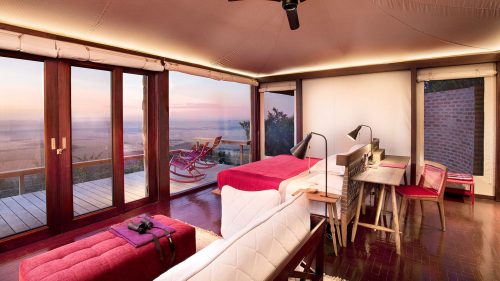The stretch of water between Lamu and Manda Islands is longer than it looks. In fact, it is centuries. As the dhow ships slip from the choppy waters of a windy day and into the waterways of Manda, I look back at the town of Lamu — buildings hovering in the island's hazy silhouette where we explored the frenetic streets, dodging donkeys and bicycles, sweating in the narrow, dusty passageways.
Now, I turn my head back to the blues and greens of the sea, sky and tangled mass of mangrove trees, the wind in my face. The channel seems to be getting narrower and narrower, and I wonder how Captain Smiley will navigate the vegetation in a sailing boat.
Both Manda and Lamu are two of seven islands within the string of the Lamu Archipelago, which clusters off the Kenyan coast. This is where Africa first connected with Eastern countries, establishing trade routes that shaped the Swahili tradition, which still vibrates along the coast today.
Captain Smiley directs us through the channels with ease. I watch him pull ropes and skip across the deck, both delicate and strong, occasionally hanging off the side. I know the sea is in his hands, body and blood. I look into the mangrove trees, the roots disappearing into the blue, and consider how the land feels like part of the sea here. The two are not separate but touch, blur into and depend on each other.
We dock at a wooden walkway and make our way on foot into Takwa. The quiet around us deepens into the song of insects and the crunch of leaves under our feet. We walk through mud and wash our feet in an old boat filled with water.
Takwa rises out of the trees. Darkened with ages, rough and broken, the buildings stand amongst giant baobabs, like a strange, old family propping each other up for centuries. We walk through the old mosque, into some of the dwellings and onto what was once a street that points directly towards Mecca, just less than a degree off true north. In the background, I hear the sound of crashing waves. I see the thriving town it was. Children running around, traders haggling in marketplaces and old people playing games. Generations lived here, were born here, died here.
And then it all went quiet. No one knows why Takwa was abandoned. Some say it was due to attacks from the nearby island of Pate, and some say it was because Manda didn’t offer a freshwater source.
We walk beyond the town and up a steep rise, where the Indian Ocean opens out in all its glory. I imagine the people of Takwa seeing the first boats on the horizon from here. I stand on the edge of the city, on the edge of the ocean, on the edge of the continent. Even the time is of the sea here — ancient and deep.
Filed under: East Africa Travel
Subscribe for Weekly Stories
Comments (0):

Tented Suites